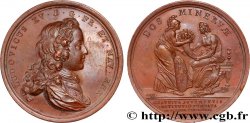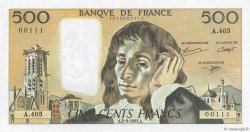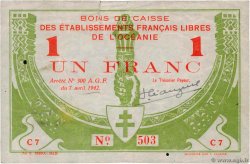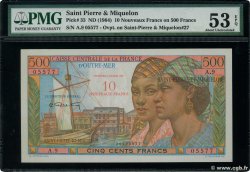E-auction 326-242293 - fme_369934 - LOUIS XV DIT LE BIEN AIMÉ Médaille du mausolée du Maréchal Maurice de Saxe
Devi Sign-in ed essere un offerente approvato fare un'offerta, Login per fare offerte. Conti sono soggetti ad approvazione e di approvazione sono raggiunti entro 48 ore. Non aspettare fino al giorno di una vendita si chiude per registrarti.Confermando la tua offerta su questo oggetto ti impegni ad un contratto legalmente vincolante per l'acquisto di questo prodotto e fare clic su «offerta» costituisce accettazione dei termini di utilizzo de e-auctions cgb.fr.
Offerta deve essere collocato in euro gli importi interi vendita only.The si chiuderà al momento sulla descrizione dell'oggetto, eventuali offerte pervenute al sito dopo l'orario di chiusura non verranno eseguite. Volte transmition possono variare e le offerte potrebbero essere respinto se si attende per gli ultimi secondi. Per ulteriori informazioni ckeck le FAQ.
SENZA COSTI PER GLI ACQUIRENTI.
SENZA COSTI PER GLI ACQUIRENTI.
| Valutazione : | 90 € |
| Prezzo : | 26 € |
| Offerta maxima : | 40 € |
| Data di fine vendita : | 15 luglio 2019 18:14:00 |
| partecipanti : | 4 partecipanti |
Tipo : Médaille du mausolée du Maréchal Maurice de Saxe
Data: 1828
Nome della officina / città: 67 - Strasbourg
Metallo : stagno
Diametro : 55 mm
Asse di coniazione : 12 h.
Incisore MULLER
Peso : 40 g.
Orlo : lisse
Marchio : sans poinçon
Commenti sullo stato di conservazione:
Médaille en étain, avec d’importantes traces de circulation. Flan voilé et troué à 12h
Diritto
Titolatura diritto : MAURIT SAXO GALL. MARESCGEN D. CURL ET SEM..
Descrittivo diritto : Buste cuirassé du maréchal à gauche.
Rovescio
Titolatura rovescio : ANÉPIGRAPHE.
Descrittivo rovescio : Mausolée du maréchal ; la Mort appelle le maréchal au tombeau, tandis que la France sous les traits d'une figure féminine en pleurs le retient du bras ; des drapeaux, un aigle et un lion rappellent la gloire militaire et la bravoure du grand soldat.
Commento
Médaille représentant le mausolée du Maréchal Maurice de Saxe à Strasbourg réalisée par Müller en 1828, dont quelques exemplaires ont été refrappés avec les coins d’origine pour le Cercle Numismatique d'Alsace en 1933.
D’autres médaille du même type sont signées D.KAN.F.E (?).
Maurice de Saxe, comte de la Raute (1696-1710) puis comte de Saxe (1710-1750), est un militaire né le 28 octobre 1696 à Goslar (duché de Saxe) et mort le 30 novembre 1750 au château de Chambord. Il était maréchal général des camps et armées de Louis XV.
Une cérémonie funèbre fut célébrée à Paris pour le maréchal de Saxe, mais le grand militaire, protestant, ne pouvait être inhumé dans la capitale. Son corps fut donc envoyé à Strasbourg (la principale ville protestante) pour être inhumé. Le corps arriva à Strasbourg le 7 février 1751 et reposa tout d'abord dans l'église du Temple Neuf où le pasteur et théologien Jean Léonard III Froereisen prononça sa Harangue. Louis XV commanda alors à Jean-Baptiste Pigalle un magnifique mausolée, élevé à partir de 1771 dans le chœur de l'église protestante Saint-Thomas, les restes du corps furent transférés dans un caveau sous ce mausolée. C'est une œuvre monumentale, dont le thème est classique: la Mort appelle le maréchal au tombeau, tandis que la France sous les traits d'une figure féminine en pleurs le retient du bras. Des drapeaux, un aigle, un lion, rappellent la gloire militaire et la bravoure du grand soldat, dont la statue altière, cuirassée, arbore un visage étonnement réaliste mais serein.
Medal representing the mausoleum of Marshal Maurice de Saxe in Strasbourg made by Müller in 1828, some examples of which were re-struck with the original dies for the Cercle Numismatique d'Alsace in 1933.
Other medals of the same type are signed D. KAN. F. E (?).
Maurice de Saxe, Count of La Raute (1696-1710) then Count of Saxe (1710-1750), was a soldier born on October 28, 1696 in Goslar (Duchy of Saxony) and died on November 30, 1750 at the Château de Chambord. He was Marshal General of the camps and armies of Louis XV.
A funeral ceremony was held in Paris for Marshal de Saxe, but the great soldier, a Protestant, could not be buried in the capital.. His body was therefore sent to Strasbourg (the main Protestant city) for burial.. The body arrived in Strasbourg on February 7, 1751 and rested first in the church of the Temple Neuf where the pastor and theologian Jean Léonard III Froereisen delivered his Harangue. Louis XV then commissioned Jean-Baptiste Pigalle to build a magnificent mausoleum, erected from 1771 in the choir of the Protestant church of Saint-Thomas. The remains of the body were transferred to a vault beneath this mausoleum.. It is a monumental work, with a classical theme: Death calls the marshal to the tomb, while France, in the form of a weeping female figure, holds him back with her arm.. Flags, an eagle, a lion, recall the military glory and bravery of the great soldier, whose haughty, armored statue displays a surprisingly realistic but serene face.
D’autres médaille du même type sont signées D.KAN.F.E (?).
Maurice de Saxe, comte de la Raute (1696-1710) puis comte de Saxe (1710-1750), est un militaire né le 28 octobre 1696 à Goslar (duché de Saxe) et mort le 30 novembre 1750 au château de Chambord. Il était maréchal général des camps et armées de Louis XV.
Une cérémonie funèbre fut célébrée à Paris pour le maréchal de Saxe, mais le grand militaire, protestant, ne pouvait être inhumé dans la capitale. Son corps fut donc envoyé à Strasbourg (la principale ville protestante) pour être inhumé. Le corps arriva à Strasbourg le 7 février 1751 et reposa tout d'abord dans l'église du Temple Neuf où le pasteur et théologien Jean Léonard III Froereisen prononça sa Harangue. Louis XV commanda alors à Jean-Baptiste Pigalle un magnifique mausolée, élevé à partir de 1771 dans le chœur de l'église protestante Saint-Thomas, les restes du corps furent transférés dans un caveau sous ce mausolée. C'est une œuvre monumentale, dont le thème est classique: la Mort appelle le maréchal au tombeau, tandis que la France sous les traits d'une figure féminine en pleurs le retient du bras. Des drapeaux, un aigle, un lion, rappellent la gloire militaire et la bravoure du grand soldat, dont la statue altière, cuirassée, arbore un visage étonnement réaliste mais serein.
Medal representing the mausoleum of Marshal Maurice de Saxe in Strasbourg made by Müller in 1828, some examples of which were re-struck with the original dies for the Cercle Numismatique d'Alsace in 1933.
Other medals of the same type are signed D. KAN. F. E (?).
Maurice de Saxe, Count of La Raute (1696-1710) then Count of Saxe (1710-1750), was a soldier born on October 28, 1696 in Goslar (Duchy of Saxony) and died on November 30, 1750 at the Château de Chambord. He was Marshal General of the camps and armies of Louis XV.
A funeral ceremony was held in Paris for Marshal de Saxe, but the great soldier, a Protestant, could not be buried in the capital.. His body was therefore sent to Strasbourg (the main Protestant city) for burial.. The body arrived in Strasbourg on February 7, 1751 and rested first in the church of the Temple Neuf where the pastor and theologian Jean Léonard III Froereisen delivered his Harangue. Louis XV then commissioned Jean-Baptiste Pigalle to build a magnificent mausoleum, erected from 1771 in the choir of the Protestant church of Saint-Thomas. The remains of the body were transferred to a vault beneath this mausoleum.. It is a monumental work, with a classical theme: Death calls the marshal to the tomb, while France, in the form of a weeping female figure, holds him back with her arm.. Flags, an eagle, a lion, recall the military glory and bravery of the great soldier, whose haughty, armored statue displays a surprisingly realistic but serene face.







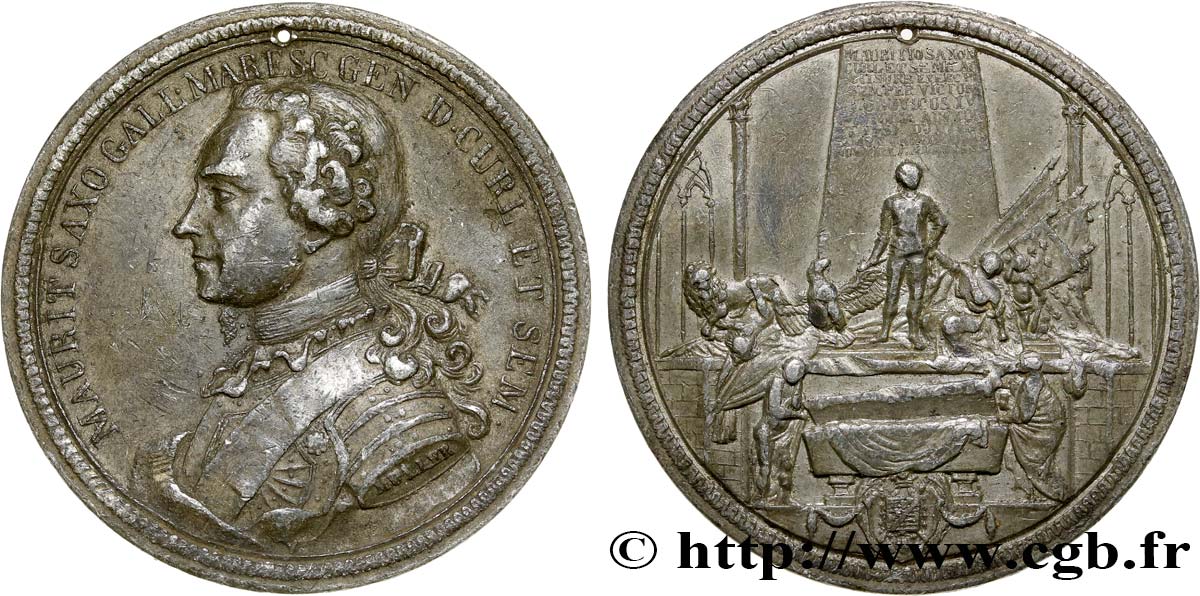
 Segnalare un errore
Segnalare un errore Stampate la pagina
Stampate la pagina Condividi mia selezione
Condividi mia selezione Fai una domanda
Fai una domanda Consegnare / vendere
Consegnare / vendere
 Descrittivo
Descrittivo